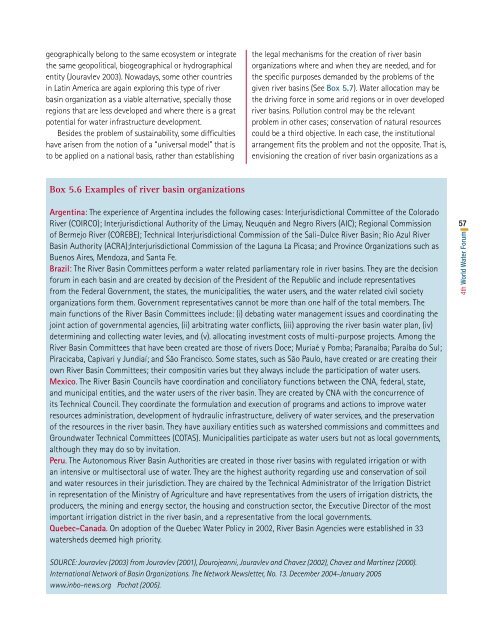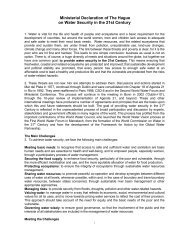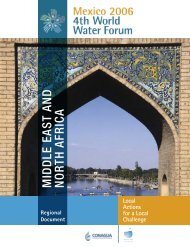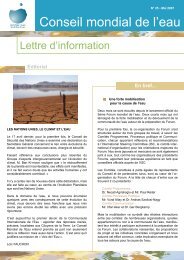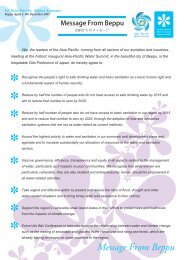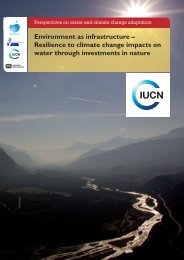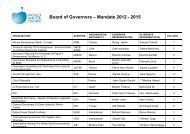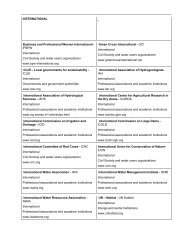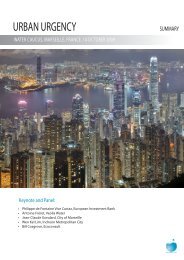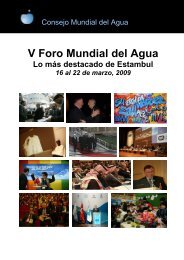Americas ok.indd - World Water Council
Americas ok.indd - World Water Council
Americas ok.indd - World Water Council
You also want an ePaper? Increase the reach of your titles
YUMPU automatically turns print PDFs into web optimized ePapers that Google loves.
geographically belong to the same ecosystem or integratethe same geopolitical, biogeographical or hydrographicalentity (Jouravlev 2003). Nowadays, some other countriesin Latin America are again exploring this type of riverbasin organization as a viable alternative, specially thoseregions that are less developed and where there is a greatpotential for water infrastructure development.Besides the problem of sustainability, some difficultieshave arisen from the notion of a “universal model” that isto be applied on a national basis, rather than establishingthe legal mechanisms for the creation of river basinorganizations where and when they are needed, and forthe specific purposes demanded by the problems of thegiven river basins (See Box 5.7). <strong>Water</strong> allocation may bethe driving force in some arid regions or in over developedriver basins. Pollution control may be the relevantproblem in other cases; conservation of natural resourcescould be a third objective. In each case, the institutionalarrangement fits the problem and not the opposite. That is,envisioning the creation of river basin organizations as aBox 5.6 Examples of river basin organizationsArgentina: The experience of Argentina includes the following cases: Interjurisdictional Committee of the ColoradoRiver (COIRCO); Interjurisdictional Authority of the Limay, Neuquén and Negro Rivers (AIC); Regional Commissionof Bermejo River (COREBE); Technical Interjurisdictional Commission of the Sali-Dulce River Basin; Rio Azul RiverBasin Authority (ACRA);Interjurisdictional Commission of the Laguna La Picasa; and Province Organizations such asBuenos Aires, Mendoza, and Santa Fe.Brazil: The River Basin Committees perform a water related parliamentary role in river basins. They are the decisionforum in each basin and are created by decision of the President of the Republic and include representativesfrom the Federal Government, the states, the municipalities, the water users, and the water related civil societyorganizations form them. Government representatives cannot be more than one half of the total members. Themain functions of the River Basin Committees include: (i) debating water management issues and coordinating thejoint action of governmental agencies, (ii) arbitrating water conflicts, (iii) approving the river basin water plan, (iv)determining and collecting water levies, and (v). allocating investment costs of multi-purpose projects. Among theRiver Basin Committees that have been created are those of rivers Doce; Muriaé y Pomba; Paranaíba; Paraíba do Sul;Piracicaba, Capivari y Jundiaí; and São Francisco. Some states, such as São Paulo, have created or are creating theirown River Basin Committees; their compositin varies but they always include the participation of water users.Mexico. The River Basin <strong>Council</strong>s have coordination and conciliatory functions between the CNA, federal, state,and municipal entities, and the water users of the river basin. They are created by CNA with the concurrence ofits Technical <strong>Council</strong>. They coordinate the formulation and execution of programs and actions to improve waterresources administration, development of hydraulic infrastructure, delivery of water services, and the preservationof the resources in the river basin. They have auxiliary entities such as watershed commissions and committees andGroundwater Technical Committees (COTAS). Municipalities participate as water users but not as local governments,although they may do so by invitation.Peru. The Autonomous River Basin Authorities are created in those river basins with regulated irrigation or withan intensive or multisectoral use of water. They are the highest authority regarding use and conservation of soiland water resources in their jurisdiction. They are chaired by the Technical Administrator of the Irrigation Districtin representation of the Ministry of Agriculture and have representatives from the users of irrigation districts, theproducers, the mining and energy sector, the housing and construction sector, the Executive Director of the mostimportant irrigation district in the river basin, and a representative from the local governments.Quebec-Canada. On adoption of the Quebec <strong>Water</strong> Policy in 2002, River Basin Agencies were established in 33watersheds deemed high priority.574th <strong>World</strong> <strong>Water</strong> ForumSOURCE: Jouravlev (2003) from Jouravlev (2001), Dourojeanni, Jouravlev and Chavez (2002), Chavez and Martinez (2000).International Network of Basin Organizations. The Network Newsletter, No. 13. December 2004-January 2005www.inbo-news.org Pochat (2005).


